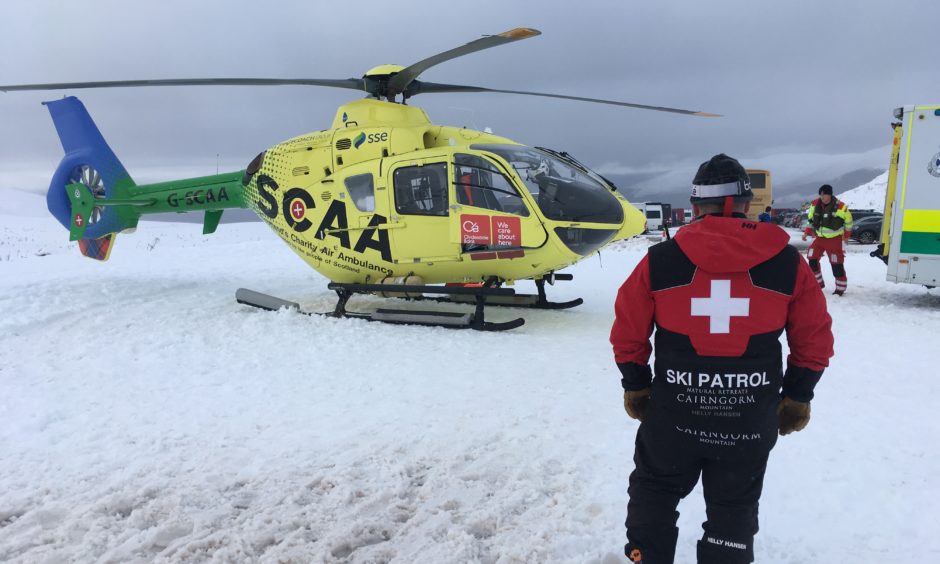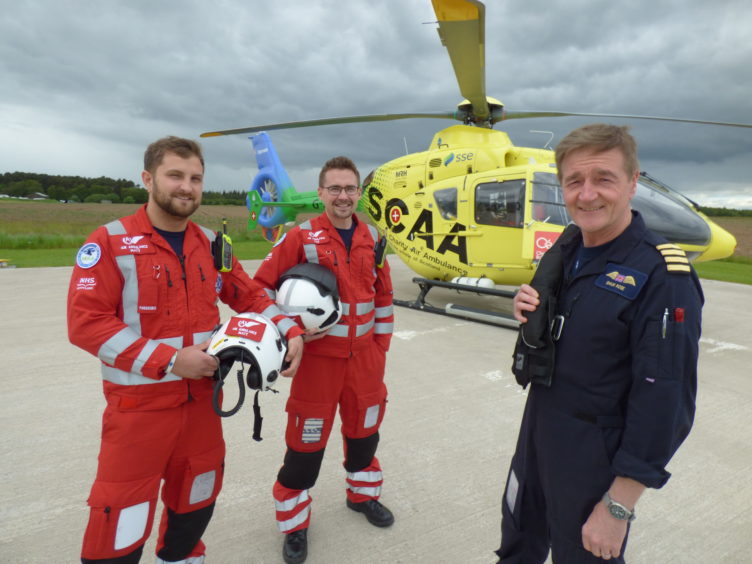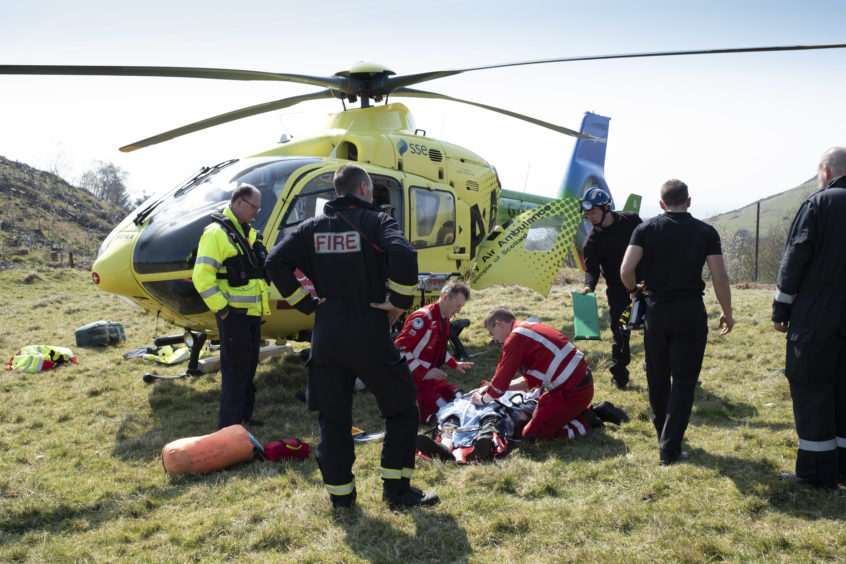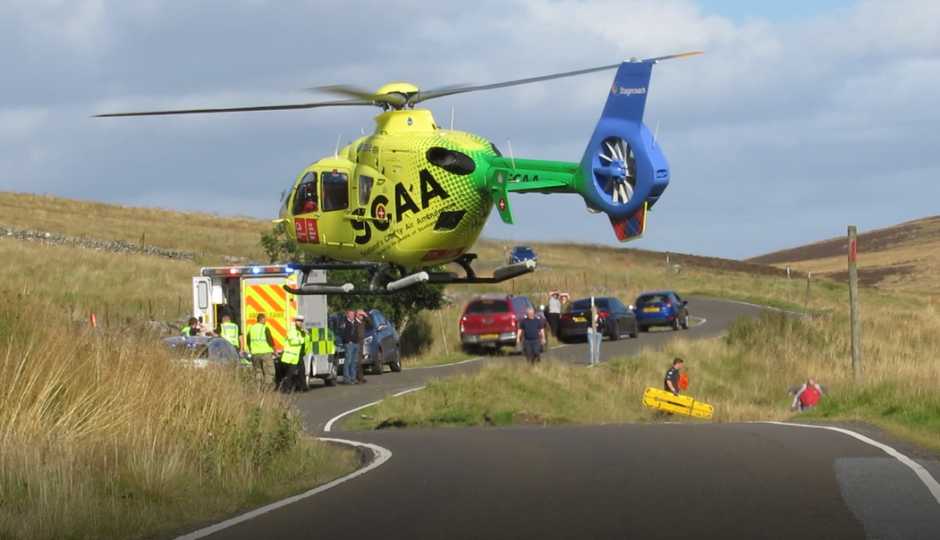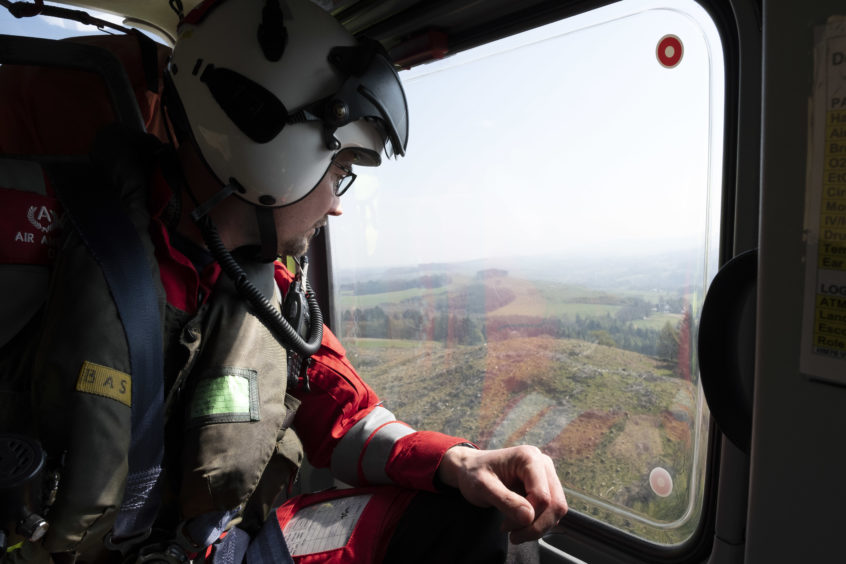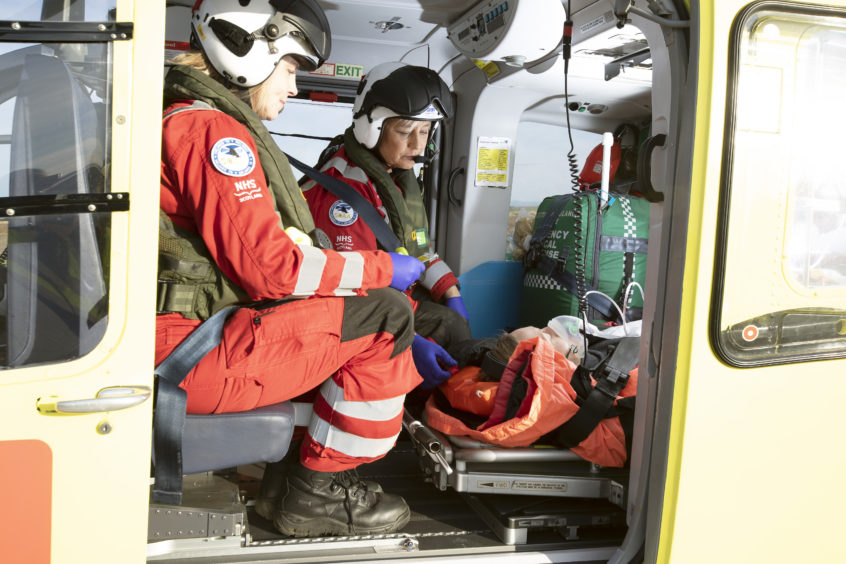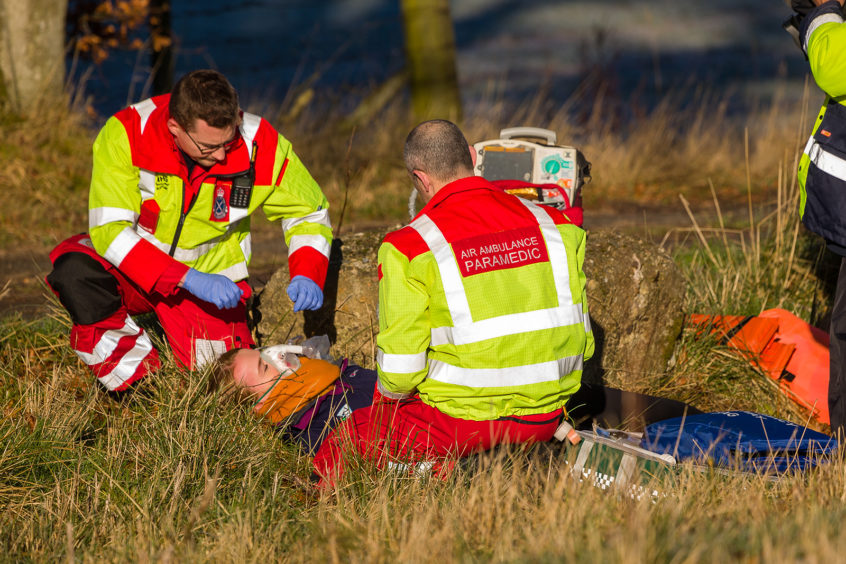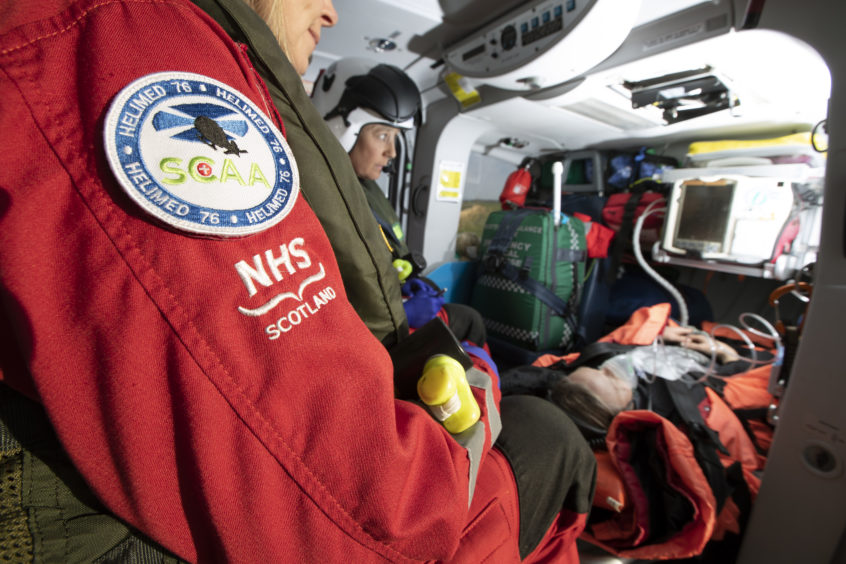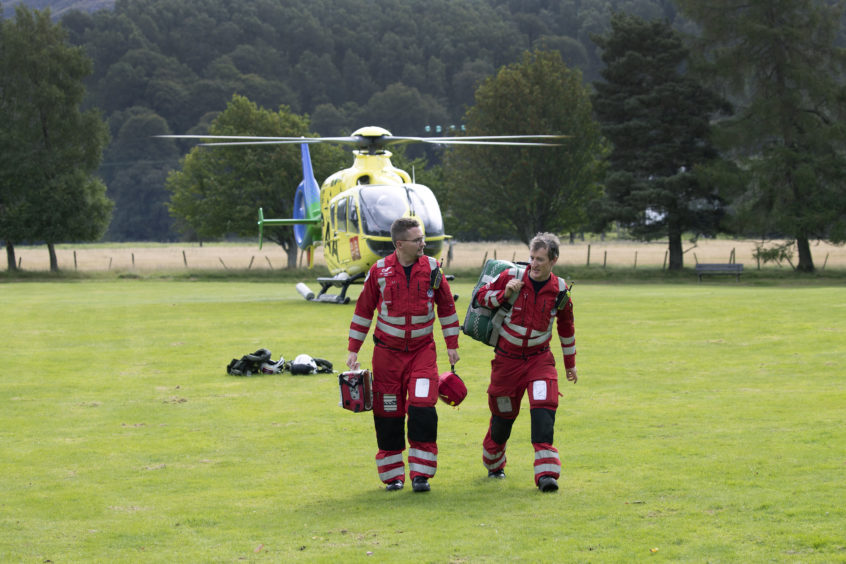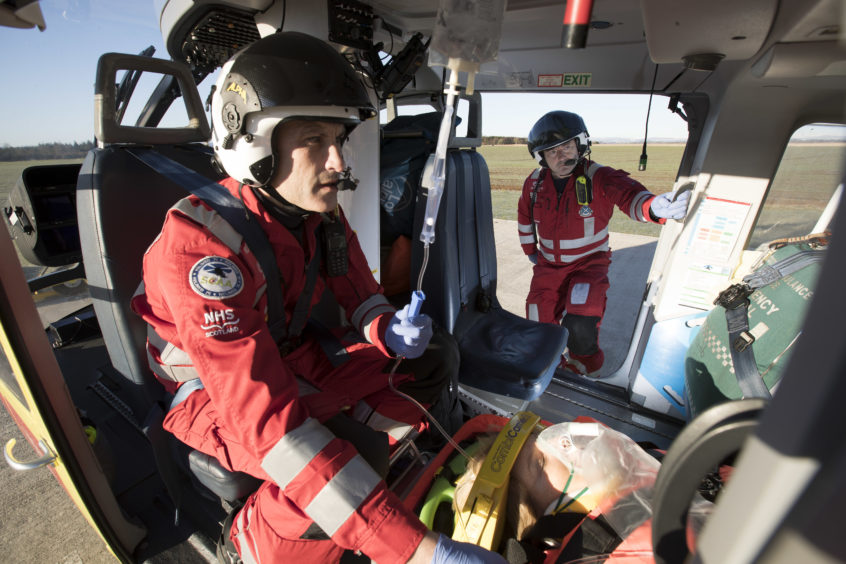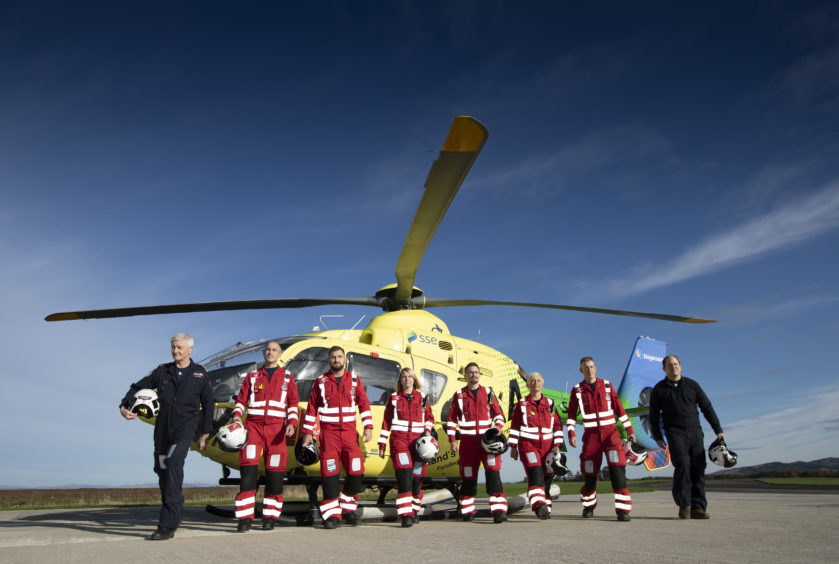With a new air ambulance service scheduled to launch in Aberdeen from March, Michael Alexander spoke to existing Scotland’s Charity Air Ambulance (SCAA) crews in Perth to find out more about their role and the challenges of winter.
A desire to “do something exciting that was different day to day” brought Kirriemuir-raised Matthew Allen into the demanding world of pre-hospital emergency care.
Having studied dentistry at Dundee University for three years before deciding it “wasn’t for me”, the former Webster’s High School pupil retrained as a paramedic with the Scottish Ambulance Service and served on the frontline of A&E for five years in Edinburgh and Dundee.
When the opportunity arose just over a year ago to join Scotland’s Charity Air Ambulance team as a paramedic, however, the now 29-year-old knew it was a chance he did not want to fly by – and he was thrilled to secure a place with the SCAA paramedic crew.
“It was the unpredictable and exciting nature of emergency work that attracted me to the Scottish Ambulance Service,” Matthew told The Courier in an interview at the SCAA headquarters at Perth Airport.
“I had worked in Edinburgh as a paramedic for the ambulance service for about five years then in Dundee for about a year before I got a job here. Regular paramedics tend to have seen it all which is why the air ambulance recruits from the ambulance service because they know they’ll get that experience.”
Having succeeded in interview, Matthew had to pass the Helicopter Underwater Escape Training (HUET) – teaching crew members how to deal with an emergency where the helicopter makes an uncontrolled descent into water.
But aircrew paramedics also have to learn how to assist the pilot from the left-hand front seat of the aircraft.
This involves passing a course which covers everything from flight training to engineering and meteorology to navigation – crucially assisting the pilot in navigating to emergencies.
“Clinically we are paramedics the same as paramedics on road ambulances,” said Matthew.
“But in addition, we have to do a technical crew member course to allow us to help the pilot in flying the aircraft and navigating and things like that.
“Over and above what we do as paramedics, we help the pilot with preparing the aircraft, maintaining it to a certain extent, making sure it’s airworthy and planning missions and navigating and getting to incidents.”
When the crew and pilot come on shift, the day starts with a briefing in the pilot’s office to discuss the weather all across Scotland.
They look at the Notams (notice to airmen) warning on the system about any events going on that could have an impact. For example, a laser show in Edinburgh or model aeroplanes flying in East Lothian. This gives them a head start if and when a call comes in to a certain area.
For the paramedic assisting the pilot with navigation up front, however, the business of talking about different routes, re-evaluating the weather, finding a safe landing spot and filtering out radio chatter from air traffic, the ambulance control room and colleagues can be all consuming.
So with the paramedic upfront potentially “maxed out” by the time they arrive at the job, it’s the paramedic who’s been sitting in the back who tends to take the lead on the ground to give their colleague a chance to recover and “step back” from what is likely to be a high trauma call-out.
One man who knows all about the importance of team work is Matthew’s Helimed 76 work partner Darren O’Brien, 42, who also entered the ambulance service after a change of career.
After a year working as a teacher which made him realise he didn’t want to work with children, the Milton Keynes-raised Keele University history and English graduate worked for a bank and as a stockbroker before deciding around the age of 25 that he didn’t want to be stuck behind a desk.
The son of Aberdeenshire-parents who moved south before he was born, he joined the South Central Ambulance Service and after five years, moved north to Dunfermline before moving into the training/education side of the Scottish Ambulance Service for 10 years.
Disillusioned with the managerial side of the job, however, he wanted back to the frontlines and was delighted to be accepted as paramedic aircrew at Perth more than a year ago.
“With the air ambulance, the front left guy will be spinning a bit so it’s important we work as a team,” said Darren.
“Equally when we are on scene the pilot will often do the same with us. We are at risk of becoming very involved with the patient and losing track of time – what’s going on in the sky with the weather.
“The pilot might come and tap us on the shoulder and say ‘just to let you know we’ve been here for 20 minutes – we need to get moving’. That’s the team dynamic.
“We need to get on well because we spend a lot of time together in very intense environments and we need to work as a team.”
Planning and weather conditions are factors for SCAA all year round.
But in winter, the weather and the type of emergencies they respond to across Scotland’s rugged and varied terrain can bring challenges of its own.
“Winter adds a layer of difficulty for navigation because of the weather and the big lumps of granite that are in the way,” said Darren.
“We’re more likely going to have to stay under the cloud because if we go up and through it when it’s freezing the copter ices up and we would fall out of the sky.
“That makes navigation more of a challenge and being aware of the weather closing in behind you.
“Yes, we get less work in winter. There are less people out on motorbikes etc. But minor injuries can become life threatening. If you hurt your ankle in the summer you can sit for ages waiting for an ambulance. If you are stuck on top of a hill in winter, your life could be in danger because of the elements rather than the actual injury.”
During winter, the extreme weather kit – paid for by the Peoples’ Postcode Lottery and carried by the SCAA – comes into its own.
The kit includes a bothy tent weather shelter that can be pulled out and used to house five or six people during extreme conditions. This generates heat and aims to warm the patient up quickly.
Other kit includes an Aerohawk sleeping bag, chemical heat packs to “boost morale” and a large blanket sleeping bag which can house the whole body yet includes various special pockets allowing the paramedic to access the patient without having to take the cover off.
Darren admits the job has personally taken him to what has been close to his “physical and mental limit.”
He recalled one occasion in summer weather when they had to climb up and down a steep hillside with kit to reach a patient who sadly could not be saved due to the extent of his injuries.
There are also days when for safety reasons they can’t respond, usually because of the weather. While those scenarios are not taken lightly, they have to be disciplined by recognising that the team has boundaries too.
Yet there are plenty occasions when the job is incredibly rewarding and even when they are worn out, and find those extra energy reserves to push on through, they try to remember that the patient is almost certainly having a worse day than them.
“At the end of the day the reason we are there is because there isn’t anyone else and we are the last chance that person has,” said Matthew reflectively.
“Walking in to someone’s house and them handing you their baby and trusting you because of the uniform you are wearing – that’s quite a responsibility!
“Even on that situation where the gentleman didn’t survive, the effect us being there had on family and friends made a real difference.
“Even in situations where we don’t get the outcome we wanted, people show their appreciation which is really nice. You feel like your efforts are being rewarded.”
Matthew and Darren recalled another incident with a happy outcome that saw them respond to a tourist who had fallen and broken his ankle on a remote part of the West Highland Way.
“The weather was shocking,” recalled Darren.
“It was chucking it down with rain. We had struggled to get there because of low cloud base. We had to land several times because we kept sinking –the ground was so waterlogged.
“Eventually we got down to the guy who was soaking wet. We got the bothy tent out etc.
“Two hillwalkers had already wrapped a foil blanket around him. They stayed to help us because of terrain and size of this guy.
“He was an ex-US medivac pilot for many years. He said ‘when I left the military all those years ago I swore I’d never get on one of those damn things again in my life!’ He was a nice chap.
“But it could have gone the other way with no one getting to him on the ground fast.
“If you had deployed a land ambulance they would have had a 45 minute walk to get to him even if they even knew exactly where he was.
“It could have been more than an hour to walk to him then think about how to get him down. That’s a great example of where SCAA makes a real difference.”
A unique collaboration between the public, private and third sectors, Scotland’s Charity Air Ambulance (SCAA) has been operating Scotland’s first and only charity funded air ambulance helicopter service otherwise known as call sign Helimed 76 from its base at Perth Airport since May 2013.
During that time, it has responded to more than 2,200 mainly high-end trauma emergencies, transporting patients in need of urgent care to hospitals across Scotland.
From Perth, and flying at two nautical miles per minute, crews can access 90% of Scotland’s population within 90 minutes but tend to cater more for rural areas.
It costs £2.5 million per year to run one aircraft with paramedics employed by the Scottish Ambulance Service but funded by the charity to be there.
A £6 million fundraising campaign is underway to launch a second aircraft – SCAA’s Helimed 79 out of a new base at Aberdeen International Airport from March.
The SCAA compliments two government funded air ambulance helicopters in Inverness and Glasgow and two government funded fixed wing aircraft flying out of Aberdeen and Glasgow.2*
The Courier told this week how the SCAA saw a 47% rise in the number of severe trauma cases it attended last year, with nearly a third being road traffic collisions.
